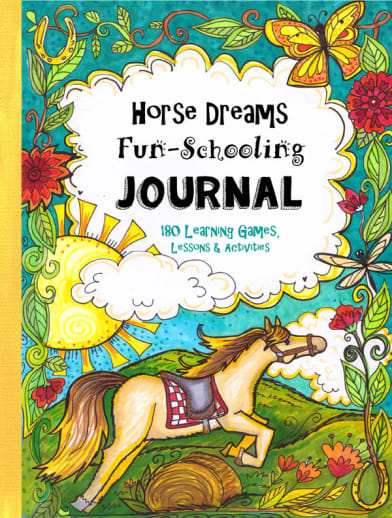Young horse lovers will enjoy the variety of horse-themed tasks in this Thinking Tree journal! It starts with a trip to the library to find 5 horse books to use in the book's activities. Choose a letter and write 10 words that start with that letter; color horse cartoons; practice cursive; make a to do list; copy a paragraph from one of the horse books; watch a movie and drawing some scenes; design a stable on graph paper, or trace a faded photograph of a horse. These activities are all repeated a few times, but can be used with a different library book each time. 180 pages for journaling. Reproducible for your own home/family use. 200pp, 7.75x11", black & white. ~Sara
Horse Dreams Fun-Schooling Journal
SKU
068490
ISBN
9781537078212
Grade 1-4
These icons are designed to help you quickly understand and learn important information about our products.
Teaching Method
Traditional
Teacher-centered curriculum commonly used in classrooms that may include a text, teacher manual, tests, etc.
Charlotte Mason
A methodology based on the work of a 19th century educator who maintained that children learn best from literature (Living Books), not textbooks.
Classical
A methodology based on the Latin Trivium (three stages of learning), including the grammar stage (memorization and facts), logic stage (critical thinking), and rhetoric stage (developing/defending ideas).
Unit Study
A thematic or topical approach centered around one topic that integrates multiple subject areas.
Montessori (Discovery)
A methodology based on the work of a 20th century educator that emphasizes student and sensory-driven discovery learning and real-life applications.
Other
Other methodologies
Religious Content
Secular
Contains content contrary to common Christian beliefs (i.e. evolution).
Neutral
Avoids religious or theoretical topics or presents multiple viewpoints without preference.
Christian/Religious
Faith-based or including instructional religious content.
Learning Modality
Auditory
Learns through listening, talking out loud or reading out loud.
Visual
Learns through seeing, prefers written instructions and visual materials.
Kinesthetic/Tactile (Hands-On)
Learns through moving, doing and touching.
Multi-Sensory
Curriculum that employ a variety of activities/components.
Presentation
Sequential
Curriculum progresses through well-defined learning objectives. Emphasizes mastery before moving to the next topic.
Spiral
Topics and concepts are repeated from level to level, adding more depth at each pass and connecting with review.
Conceptual/Topical
Focus is on the “why,” often with a unifying concept as well as specific skills; coverage may be broader.
Teacher Involvement
Low Teacher Involvement
Student-led materials; parent acts as a facilitator.
Medium Teacher Involvement
A mix of teacher-led time and independent student work.
High Teacher Involvement
Teacher-led lessons; may utilize discussions, hands-on activities and working together.
Additional Materials Required
No other materials needed
Everything you need is included.
Other Materials Required
There are additional required resources that are a separate purchase.
Other Materials Optional
There are additional resources mentioned or recommended but are not absolutely necessary.
Consumable
Consumable
Designed to be written in; not reusable.
Non-Consumable
Not designed to be written in; reusable.
Our Price
$28.50 $28.50 $22.75
Rainbow Savings: $5.75
Description
Publisher's Description of Horse Dreams Fun-Schooling Journal
Your horse loving student will adore this homeschooling journal! This book provides 180 learning activities, games and lessons related to the study of horses. The curriculum is designed to be used by children who can read at a second grade level, though younger children can use the curriculum with a little extra help.
Details
| Product Format: | Paperback |
|---|---|
| Grades: | 1-4 |
| Brand: | The Thinking Tree |
| Author: | Sarah Janisse Brown |
| ISBN: | 9781537078212 |
| Length in Inches: | 11 |
| Width in Inches: | 7.75 |
| Height in Inches: | 0.5625 |
| Weight in Pounds: | 1.1 |
Videos
Reviews

